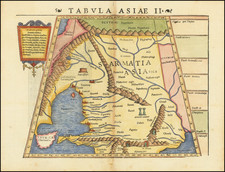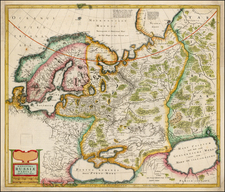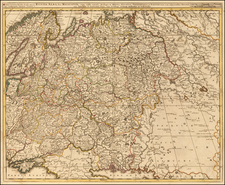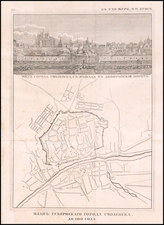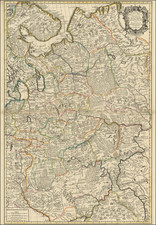A very fine acquatint rendering of Lieutenant Montague O'Reilly's celebrated view of Sebastopol, taken before the year-long siege of the city during Crimean War.
This fine birds-eye view showcases the heavily fortified port of Sebastopol, Crimea, the base of Russia's Black Sea Fleet. The town is nestled in a deep, narrow harbor, with hills in the background. A key along the bottom identifies 22 key sites of interest. The compositon is finely rendered and the original acquatint color is still bright and fresh.
The Crimean War (1853-55), pitted an alliance of Britain, France and the Ottoman Empire against Russia, and was principally fought along the shores of the Black Sea. Naturally, Sebastopol was of particular interest to the Allies. On January 6, 1854, the HMS Retribution, commanded by Lieutenant Montague O'Reilly (1822-1888) made a reconaissance visit to the waters just south of the city. O'Reilly was an accomplished artist and found the time to make a detailed skectch of Sebastopol, which he later refined in order to perfect its appearance. Turkish officials in Istanbul, who had never seen the fabled Sebastopol, were highly impressed and arranged for O'Reilly to have a rare personal audience with Ottoman Sultan Abdülmecid I, in order to show him his sketch.
O'Reilly's great work was first duplicated and published in London in June 1854, with the present fine edition being issued by the Benedetto Marzolla in Naples. in September, 1854. It is evidence of the extent to which interest in the Crimean War had gripped all of Europe.
O'Reilly's view was also timely, as the Allies landed at Eupatoria, Crimea, on September 14, 1854, intending to march to Sevastopol, with 50,000 men. What was expected to be a brisk 35 mile trek leading to Sebastopol's capture horrifically turned into a year of ferocious close-quarters combat, as the Russians put up unexpectedly stiff resistance. The major battles along the way were Alma (September 1854), Balaklava (October 1854), Inkerman (November 1854), Tchernaya (August 1855), Redan (September 1855) and finally, Sevastopol (September 1855). During the siege, the Allied navies undertook six bombardments of the Sevastopol, on October 17, 1854 and April 9, June 6, June 17, August 17 and September 5, 1855.
Sevastopol is considered to be one of the classic sieges of all time. In September, 1855, the Russian field army withdrew before the Allies could encircle the city, which secured Sebastopol's surrender shortly thereafter. The siege was the final episode in the Crimean War, which caused the Russians to sue for peace and to conclude the war on Allied terms.
O'Reilly's view of Sebastopol is perhaps the finest and most celebrated view of the city from the period and is one of the most attractive prints of the Crimean War.









